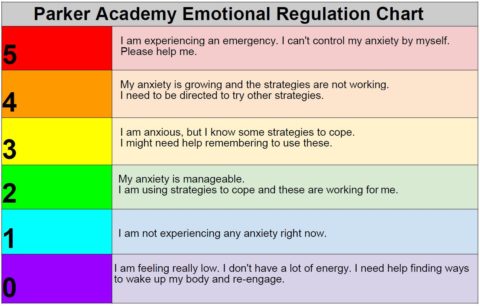 At Parker Academy, we help students learn how to regulate their behaviors. We utilize an “Emotional Regulation” chart to help students identify their emotional level and help them to develop strategies to manage their emotions. The lessons and learning activities that we use are designed to help students recognize when they are in the different zones as well as how to use strategies to change the zone they are in.
At Parker Academy, we help students learn how to regulate their behaviors. We utilize an “Emotional Regulation” chart to help students identify their emotional level and help them to develop strategies to manage their emotions. The lessons and learning activities that we use are designed to help students recognize when they are in the different zones as well as how to use strategies to change the zone they are in.
In addition to addressing self-regulation, students gain an increased awareness of emotional terms, develop skills in reading other people’s facial expressions, and gain a better perspective about how others see and react to their behavior. Students gain better insight into events that may trigger their behavior, and develop calming, alerting, and problem solving strategies.
Parents can help the efforts of the school and the student. Your child’s advisor can provide you with a copy of the “Emotional Regulation” chart or you can use the one that has been attached.
Parents can help by using language similar to what is used at the school and talk about the concepts of the emotional regulation zones as they apply to you in a variety of environments.
You can comment aloud so that your child understands that everyone experiences the different zones and use strategies to control (or regulate) ourselves.
For example, “This is really frustrating me and making me go into the Yellow Zone.”
“I need to use a tool to calm down.” “I will take some deep breaths and practice mindfulness.” Help your child gain awareness of his or her emotional regulation zones and feelings by pointing out your own.
Parents can talk about what zone is “expected” in the situation or how a zone may have been “unexpected.” They can share with the student how his or her behavior is affecting the zone you are in and how you feel. Parents can help the student become comfortable using language to communicate his or her feelings and needs, encouraging the student to share his or her zone with you.
Ask the student if s/he wants reminders to use these tools and how you should present these reminders. Ask the student to frequently share his or her Zones Folder with you and talk about what he or she has learned.
Make sure you frequently reinforce the student for being in the expected zone rather than only pointing out when his or her zone is unexpected. It is important to note that everyone experiences all of the zones. All of the zones are expected at one time or another. The Zones of Regulation are intended to be neutral and not communicate judgment.
With your support at home, your child can benefit from learning how to identify their regulation level and then develop strategies to manage their behavior.

